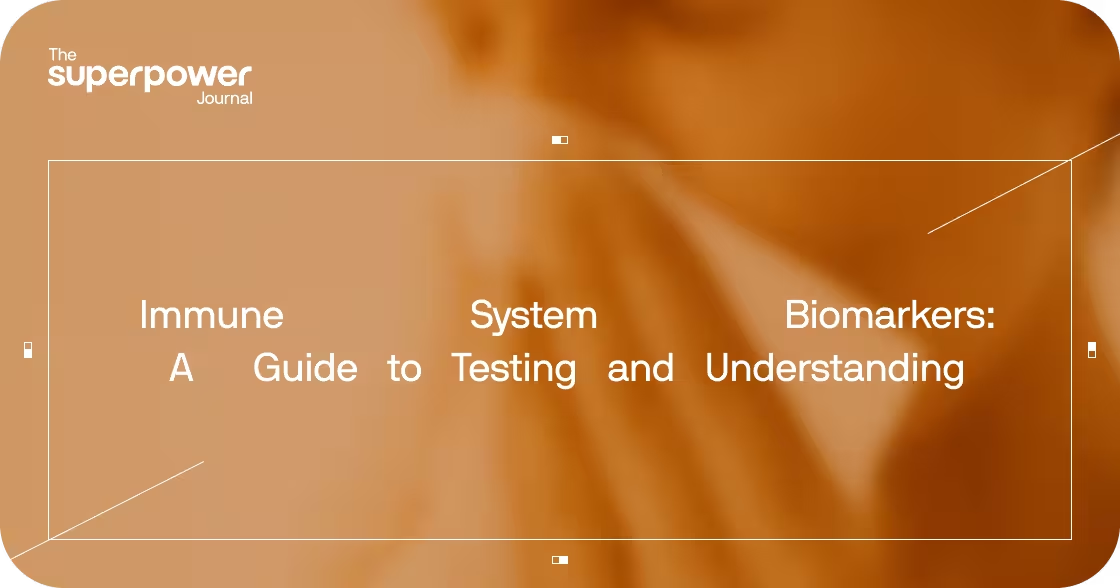Why DNA Biomarker Dysfunction Matters
Genetic variation influences how our bodies age, respond to diet, metabolize drugs, and develop chronic disease. Although lifestyle is the primary driver of health outcomes, inherited DNA biomarkers can increase susceptibility to conditions such as cardiovascular disease, type 2 diabetes, and neurodegeneration¹ ². These markers provide insight into the biological pathways that differ among individuals, helping explain why some people face higher risks despite similar lifestyles.
DNA biomarkers are not deterministic. Carrying genetic risk variants does not guarantee disease. Instead, they interact with environment, lifestyle, and epigenetic factors, creating different trajectories for health and aging³. By identifying these inherited variations, health professionals can shift from reactive medicine to proactive prevention. Testing can highlight who may benefit from more frequent monitoring, altered nutrient requirements, or tailored approaches for conditions such as diabetes, cardiovascular disease, or dementia⁴.
Systems Biology: How DNA Biomarkers Shape the Body
Genes rarely function in isolation. They exert effects through networks of enzymes, receptors, and structural proteins that collectively regulate core physiological systems. Well-characterized examples include:
- Metabolism and Energy Regulation: Variants in FTO and TCF7L2 influence insulin sensitivity, energy balance, and fat storage, affecting type 2 diabetes and obesity risk⁵ ⁶.
- Cardiovascular Health: Alleles in APOE and PCSK9 alter cholesterol transport and metabolism, shaping cardiovascular disease risk⁷ ⁸.
- Detoxification and Oxidative Stress: Null variants in glutathione-related genes (GSTM1, GSTT1) impair detoxification capacity and increase oxidative stress⁹.
- Brain and Cognition: Carriage of APOE ε4 strongly increases risk for late-onset Alzheimer’s disease, while variants in BDNF and COMT influence neuronal plasticity and neurotransmitter regulation¹⁰.
- Hormone and Nutrient Regulation: Variants in MTHFR affect folate metabolism, while differences in the vitamin D receptor (VDR) modify calcium absorption and bone mineralization¹¹ ¹².
These interconnected pathways reveal why certain DNA variants can exert systemic effects, such as oxidative stress leading to vascular damage, which in turn affects cognitive decline.
What DNA Biomarkers Are
DNA biomarkers are genetic variations—such as single nucleotide polymorphisms (SNPs), insertions/deletions, or structural changes—that provide measurable information about biological function, disease risk, or therapeutic response. Unlike dynamic biomarkers (e.g., glucose or cholesterol), DNA biomarkers are fixed from conception. However, their functional effects may be modified by epigenetics, diet, and lifestyle¹³.
Major categories include:
- Single Nucleotide Polymorphisms (SNPs): Most common form of variation, often impacting enzyme activity (e.g., MTHFR C677T).
- Copy Number Variations (CNVs): Segmental duplications or deletions that alter gene dosage (e.g., AMY1 copy number variation affecting starch digestion).
- Risk vs. Protective Alleles: Certain variants increase disease susceptibility, while others confer resilience.
- Polygenic Risk Scores (PRS): Tools that integrate hundreds or thousands of SNPs to estimate cumulative genetic risk for common conditions such as type 2 diabetes and coronary artery disease¹⁴.
U.S. Population Insight
Approximately 20–25% of Americans carry at least one copy of APOE ε4, substantially raising lifetime risk for Alzheimer’s disease and influencing lipid metabolism¹⁰. This prevalence illustrates why genetic predispositions are common rather than exceptional and why DNA testing can inform preventative health strategies.
Key DNA Biomarkers and Their Functions
Cardiometabolic Biomarkers
- APOE (ε2, ε3, ε4): Involved in cholesterol transport; ε4 increases Alzheimer’s and cardiovascular risk¹⁰.
- PCSK9: Variants affect LDL cholesterol clearance, influencing cardiovascular disease susceptibility⁸.
- FTO: Associated with increased body mass index and obesity risk, particularly through effects on energy balance⁵.
- TCF7L2: Strongly associated with risk of type 2 diabetes, among the most consistently replicated markers⁶.
Detoxification and Oxidative Stress Biomarkers
- GSTM1 and GSTT1 (null variants): Loss of enzyme activity increases vulnerability to oxidative stress⁹.
- SOD2: Polymorphisms affect mitochondrial antioxidant activity, linked to oxidative damage¹⁵.
- NQO1: Variants modify detoxification of carcinogens and redox cycling¹⁶.
Nutrient and Hormone-Related Biomarkers
- MTHFR (C677T, A1298C): Polymorphisms impair folate metabolism, elevating homocysteine and influencing cardiovascular and neural tube defect risk¹¹.
- Vitamin D receptor (VDR): Allelic variation affects bone mineral density and immune response¹².
- CYP1A1 and CYP1B1: Polymorphisms influence estrogen metabolism, with potential cancer susceptibility relevance¹⁷.
Cognitive and Neurological Biomarkers
- APOE ε4: Major genetic risk factor for late-onset Alzheimer’s disease¹⁰.
- COMT Val158Met: Alters dopamine degradation, affecting cognition and psychiatric vulnerability¹⁸.
- BDNF Val66Met: Impacts synaptic plasticity and hippocampal function¹⁹.
DNA Biomarkers and Their Interpretation
Unlike blood-based measures, DNA biomarkers are categorical. Their interpretation depends on whether an individual carries risk alleles, protective alleles, or neutral variants. For example:
- APOE ε4 increases Alzheimer’s risk in a dose-dependent manner¹⁰.
- MTHFR C677T homozygotes show reduced enzyme activity and higher homocysteine¹¹.
- GSTM1 null genotype leads to reduced detoxification capacity⁹.
Importantly, these genotypes are not inherently “abnormal.” Instead, they indicate biological predispositions that may require mitigation through environment and lifestyle.
What Imbalanced Profiles Indicate
When an individual carries several disadvantageous variants, it can create heightened susceptibility in specific domains:
- Oxidative stress: GSTM1 null or SOD2 variants reduce cellular defense against free radicals⁹ ¹⁵.
- Methylation inefficiency: MTHFR C677T raises homocysteine, linked to vascular risk¹¹.
- Neurodegeneration: APOE ε4 promotes β-amyloid deposition and impairs brain resilience¹⁰.
- Glucose dysregulation: TCF7L2 increases diabetes susceptibility, particularly in contexts of high refined carbohydrate intake⁶.
These do not predetermine outcomes but highlight areas requiring proactive monitoring.
Longevity Connections of DNA Biomarkers
DNA biomarker pathways overlap with mechanisms of cellular aging:
- Oxidative Stress: Variants in SOD2 and GST family genes can exacerbate mitochondrial free radical damage¹⁵.
- Methylation and Epigenetic Stability: MTHFR C677T polymorphisms alter methyl donor supply, with downstream implications for DNA stability and vascular health¹¹.
- Nutrient-Sensing Pathways: Longevity-associated genes such as FOXO3 and MTOR variants influence resilience to stress and cellular maintenance²⁰.
- Glucose Regulation: TCF7L2 variants accelerate advanced glycation, damaging proteins and vessels over time⁶.
Together, these help explain variability in healthy aging among individuals with comparable lifestyles.
Optimizing Lifestyle in the Context of DNA Biomarkers
Genetic predispositions can often be mitigated through lifestyle and environmental inputs:
- Nutrition: MTHFR carriers may benefit from ensuring adequate intake of bioactive folate (5-MTHF) to maintain methylation capacity¹¹.
- Exercise: Consistent activity mitigates insulin resistance risk linked to FTO and TCF7L2 polymorphisms⁵ ⁶.
- Sleep and Neuroprotection: Adequate restorative sleep is critical for sustaining detoxification and mitochondrial repair, particularly in those with reduced oxidative defenses⁹.
- Micronutrients: Individuals with reduced VDR efficiency may require closer monitoring of vitamin D status¹².
These adjustments do not alter the underlying gene but buffer its impact.
Why Testing DNA Biomarkers Matters
DNA biomarker testing is a cornerstone of precision medicine. Because the genome is stable, testing usually occurs once, with results valid across the lifespan. Key applications include:
- Risk Stratification: Early identification of APOE ε4 carriers for proactive Alzheimer’s prevention¹⁰.
- Nutritional Guidance: Identifying MTHFR variants to adjust folate strategies¹¹.
- Pharmacogenomics: Predicting drug response, such as statins or antidepressants, based on genetic variants²¹.
- Family Planning: Assessing hereditary risks through DNA testing.
Testing is most useful for individuals with strong family histories, unexplained clinical findings, or those pursuing preventive health and longevity.
Integrating DNA Biomarkers with Other Health Data
While DNA biomarkers establish predispositions, their real value emerges when combined with dynamic biomarkers such as glucose, cholesterol, or inflammatory markers. Integration enables clinicians and individuals to align risk with current physiology, creating a more accurate and personalized health strategy.
Ready to test your biomarkers? Join Superpower today to access advanced biomarker testing with over 100 lab tests.




.avif)
.png)





.svg)


